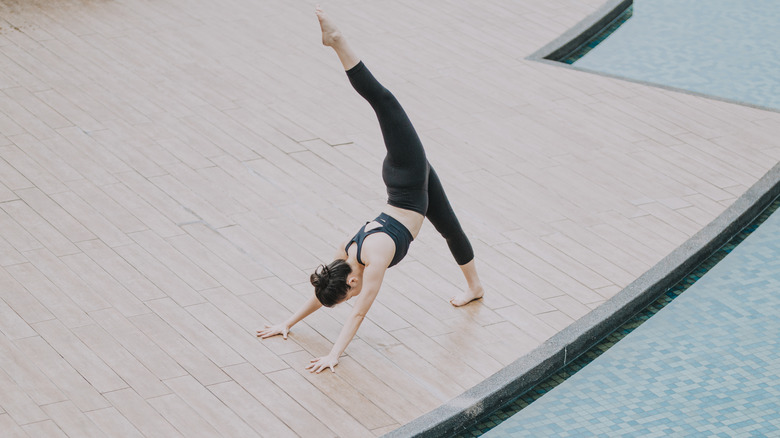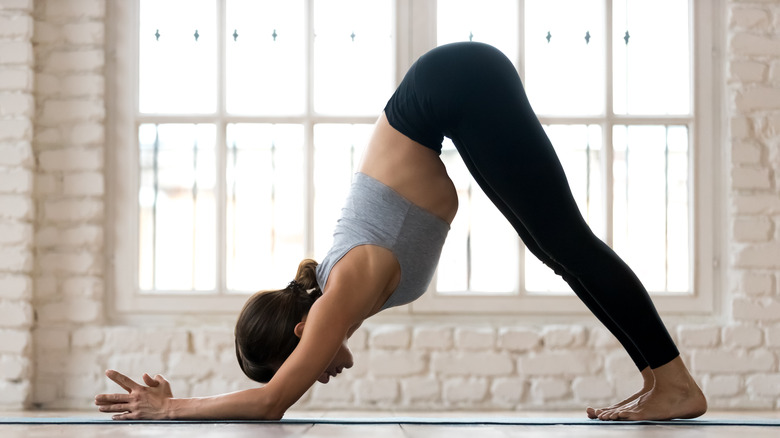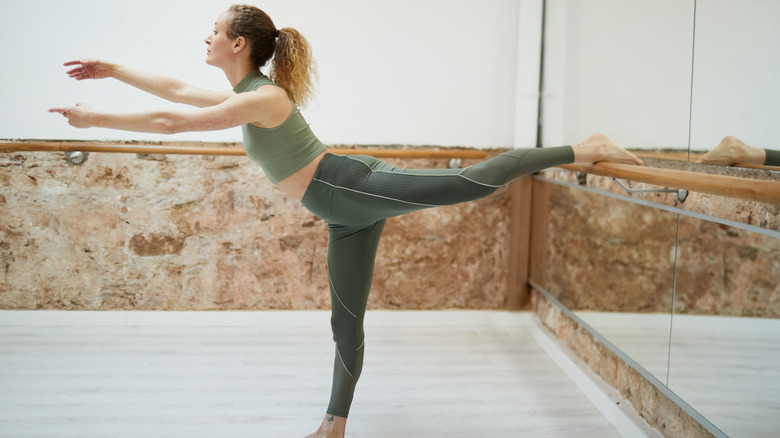The Benefits Of Doing Standing Splits Pose In Yoga
Unless you're a ballet dancer or gymnast, many people can't do a split because it requires both flexibility and strength. Yet standing splits are often part of an intermediate yoga class. A standing split can be much easier than a traditional split because your legs really don't need to split in opposite directions. Instead, a standing split might look more like a standing L-shape. It's essentially a one-legged forward fold (via Alo Moves).
No matter how high (or not) you elevate the floating leg in a standing split, you'll still reap the benefits of this pose through continual practice. Standing splits can help ease tension and tightness by stretching the hamstrings of the standing leg. You'll get a nice stretch at the top of the hip of the elevated leg, especially if you do your best to keep the hips level. Plus, your lower back will love the spine decompressing in this pose. On top of that, standing splits build strength in the hips, back, and standing leg. Because standing splits require you to balance on one leg, you'll also improve your balance, focus, and concentration. You might feel a sense of calm because the standing split pose is both an inversion and a forward bend (via Yoga Collective).
How to do a standing split
You'll want to warm up your body, particularly your hamstrings, before practicing standing splits. You can start with a few sun salutations or rocking back and forth between plank and downward dog. Bring your body to a forward fold and allow your hamstrings to begin feeling more stretched. Bend your knees slightly if your hamstrings are especially tight. This will also allow you to touch the floor.
Shift your weight onto your left leg and ground down with the left foot, feeling all the muscles in your foot grip the floor. While keeping your hips as level as possible, draw the right leg as high as possible without too much strain. Your left foot, knee, and hip should be on the same vertical line. Try to imagine your inner thighs squeezing together (via Alo Moves). Lengthen your neck and spine by reaching the crown of the head towards the floor. You can keep your hands on the floor to maintain your balance or try walking your hands towards your left ankle. After a few deep, calming breaths, lower the right leg and repeat on the other side.
Standing split modifications and contraindications
The standing split is an intermediate pose, so there are a few modifications for beginners to make it more accessible to your body. If you can't reach the floor with your hands to begin the standing split, place your hands on blocks or hold onto a chair to shorten the distance to the floor. Resting the lifted leg on a chair or table can allow you to stretch and strengthen the standing leg a little longer. A wall can help you get deeper into the pose. To do this, begin in a standing forward bend with the wall a few feet behind you. As you raise one leg off the floor, press the top of the foot against the wall to stretch the top of the hip (via Everyday Yoga).
Standing splits will put a lot of pressure on the hip, knee, and ankle of the standing leg, so you'll want to modify or skip standing splits if these areas are injured. This pose might also pose problems for people with high or low blood pressure (via OMStars). You should also skip standing splits if you have problems with vertigo or balance.



